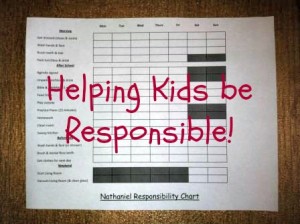
As parents, one of our most important jobs is training our children to become responsible adults someday. Besides the obvious societal implications of this (you know, stuff like self-sufficiency, good citizens who pay their taxes, staying out of prison and all that jazz), there are plenty of selfish ones as well. Although we love having them around while they’re small and cute, the last thing we want is some 35 year-old living in our basement playing video games and mooching all our food. (Now when we’re old and living in THEIR basement, that’s just payback!)
Although we’re still at the beginning of this wild and crazy adventure called parenthood, we’ve already encountered more than a few roadblocks along the way. We figured we were all set when we read James Dobson’s ‘Bringing up Boys’ and a few other parenting books. Turns out, teaching children to be responsible is harder than we ever thought it would be when our kids were in diapers and all this was just theoretical. In reality, putting that stuff into practice and being consistent at it every day is one of the toughest things we will ever do in life.
We’re learning the hard way with our oldest, third-grader Nathaniel. Oh, he’s a great kid – has a good attitude, makes good grades, is a good older brother to his sisters – but, as we try to give him more and more responsibility he has a hard time keeping up with all the things expected of him. We constantly had to remind him to do his chores, do his homework, feed his dog, practice his piano, etc. When he was supposed to be getting ready for school or doing his chores, we’d find him doing something completely unrelated to what he was supposed to be doing – arranging his football cards, standing with his hands in his pockets, aggravating his sisters, you name it.

Getting four kids ready for school is hard enough when everyone pulls their weight!
Apparently, this is a common thing for boys his age. Nevertheless, we decided long ago that letting our children be irresponsible isn’t doing them any favors in the long run, so we put our heads together to think of a way to help Nathaniel (and our other children as they grow older) keep up with all the things he’s supposed to remember to do on his own without our constant reminding, prodding, and nagging.
We came up with the ‘Responsibility Chart.’ Far from a simple ‘chore chart,’ the Responsibility Chart helps our older children keep up with all of the things they are expected to do during their busy days, and do so without overburdening them, stifling creativity, or micro-managing every minute of their day.
Here’s how it works:
1.) The row headers are the individual responsibilities, divided into subcategories of when those responsibilities are expected to be accomplished. In Nathaniel’s case, his chores for the ‘morning’ are: get dressed, wash hands & face (hey, he forgets!), brush teeth & hair, pack backpack with books, lunchbox, and drink. His ‘after school’ responsibilities include: get agenda signed (from school), unpack backpack, at least 15 minutes of devotions and studying his AWANA Bible verses, feed the dog, play outside (weather permitting – yes, we believe it’s important for our kids to play outside! :)), practice piano (number of minutes defined depending on grade and level), complete all homework, clean his room, and sweep the kitchen. After dinner and before bed his responsibilities are: shower, brush & dental floss teeth, and get his clothes ready for the next day. On weekends there are special chores like dusting and vacuuming the living room, cleaning windows, etc. Piece of cake!
2.) The column headers list each day of the week. On weekends, certain chores are ‘blacked out.’ For example, there’s no need to unpack backpacks on non-school days.
3.) Each box gets checked by the child when the responsibility is completed. If a responsibility isn’t completed for a legitimate reason (vacation, school out, out to dinner, etc.), the child writes a brief explanation in the square (out to eat, no homework, etc).
4.) If a responsibility isn’t completed, the child marks the box with an X.
5.) A completed chore chart at the end of the week is worth 1 week’s ‘allowance.’ A percentage of that allowance is deducted for each X. One exception – if Nathaniel forgets to feed the dog (don’t worry, our dog doesn’t have to fast – I take care of feeding the pooch on those days! :)) he loses his entire allowance for the week (but still has to do his chart!). We think it’s important to teach that some responsibilities are more important than others. Hey, can you blame us for not wanting him to forget to someday feed our grandchildren?!
The Responsibility Chart is meant to be a bridge between early childhood and the responsibilities that come with being an all-day student. We recently made one for our first-grader too, with a few of the same and a few responsibilities. It is positive reinforcement that motivates our children to complete their responsibilities without having to be constantly reminded. It isn’t perfect, but it’s worked well for us so far. If you have younger kids, maybe it will for you!

Some chores don’t need a chart because they are just FUN – Abby loves helping Mommy string beans!
PS – If you enjoy our posts, please consider signing up for our newsletter and helping us grow our Facebook page by clicking ‘like’ in the box to the right of this page!






